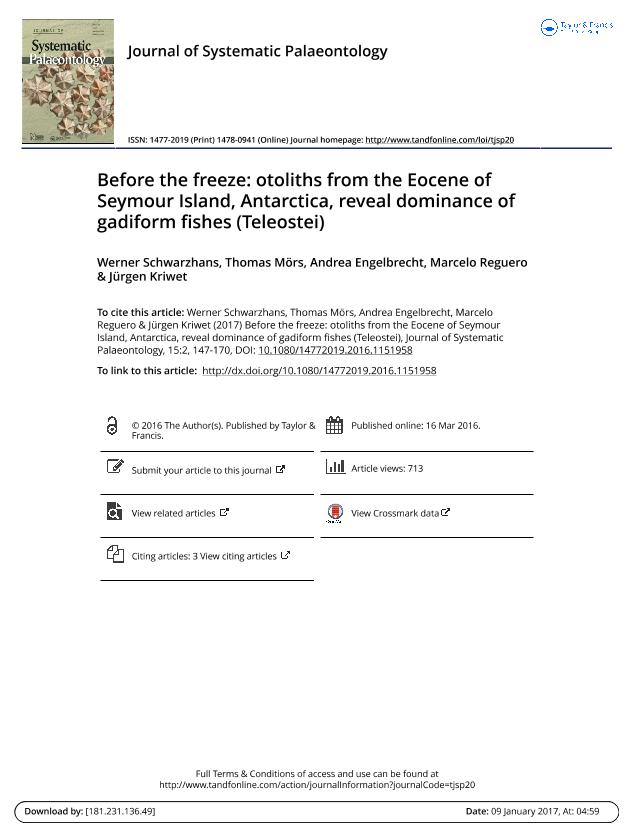Artículo
Before the freeze: otoliths from the Eocene of Seymour Island, Antarctica, reveal dominance of gadiform fishes (Teleostei)
Fecha de publicación:
02/2017
Editorial:
Cambridge University Press
Revista:
Journal of Systematic Palaeontology
ISSN:
1477-2019
Idioma:
Inglés
Tipo de recurso:
Artículo publicado
Clasificación temática:
Resumen
The first record of fossil teleostean otoliths from Antarctica is reported. The fossils were obtained from late Early Eocene shell beds of the La Meseta Formation, Seymour Island that represent the last temperate marine climate phase in Antarctica prior to the onset of cooling and subsequent glaciation during the late Eocene. A total of 17 otolith-based teleost taxa are recognized, with 10 being identifiable to species level containing nine new species and one new genus: Argentina antarctica sp. nov., Diaphus? marambionis sp. nov., Macruronus eastmani sp. nov., Coelorinchus balushkini sp. nov., Coelorinchus nordenskjoeldi sp. nov., Palimphemus seymourensis sp. nov., Hoplobrotula? antipoda sp. nov., Notoberyx cionei gen. et sp. nov. and Cepola anderssoni sp. nov. Macruronus eastmani sp. nov. is also known from the late Eocene of Southern Australia, and Tripterophycis immutatus Schwarzhans, widespread in the southern oceans during the Eocene, has been recorded from New Zealand, southern Australia, and now Antarctica. The otolith assemblage shows a typical composition of temperate fishes dominated by gadiforms, very similar at genus and family levels to associations known from middle Eocene strata of New Zealand and the late Eocene of southern Australia, but also to the temperate Northern Hemisphere associations from the Paleocene of Denmark. The Seymour Island fauna bridges a gap in the record of global temperate marine teleost faunas during the early Eocene climate maximum. The dominant gadiforms are interpreted as the main temperate faunal component, as in the Paleocene of Denmark. Here they are represented by the families Moridae, Merlucciidae (Macruroninae), Macrouridae and Gadidae. Nowadays Gadidae are a chiefly Northern Hemisphere temperate family. Moridae, Macruroninae and Macrouridae live today on the lower shelf to deep-water or mesopelagically with Macruroninae being restricted to the Southern Ocean. The extant endemic Antarctic gadiform family Muraenolepididae is missing, as are the dominant modern Antarctic fishes of the perciform suborder Notothenioidei. Recently, there has been much debate on isolated jaw bones of teleost fishes found in the La Meseta Formation and whether they would represent gadiforms (Merlucciidae in this case) or some early, primitive notothenioid. Otoliths are known to often complement rather than duplicate skeletal finds. With this in mind, we conclude that our otolith data support the presence of gadiforms in the early Eocene of Antarctica while it does not rule out the presence of notothenioids at the same time. http://zoobank.org/urn:lsid:zoobank.org:pub:A30E5364-0003-4467-B902-43A41AD456CC
Palabras clave:
Antarctica
,
Eocene
,
Gadiformes
,
Macrouridae
,
Macruronus
,
Temperate Climate
Archivos asociados
Licencia
Identificadores
Colecciones
Articulos(CCT - LA PLATA)
Articulos de CTRO.CIENTIFICO TECNOL.CONICET - LA PLATA
Articulos de CTRO.CIENTIFICO TECNOL.CONICET - LA PLATA
Citación
Schwarzhans, Werner; Mörs, Thomas; Engelbrecht, Andrea; Reguero, Marcelo Alfredo; Kriwet, Jürgen; Before the freeze: otoliths from the Eocene of Seymour Island, Antarctica, reveal dominance of gadiform fishes (Teleostei); Cambridge University Press; Journal of Systematic Palaeontology; 15; 2; 2-2017; 147-170
Compartir
Altmétricas




